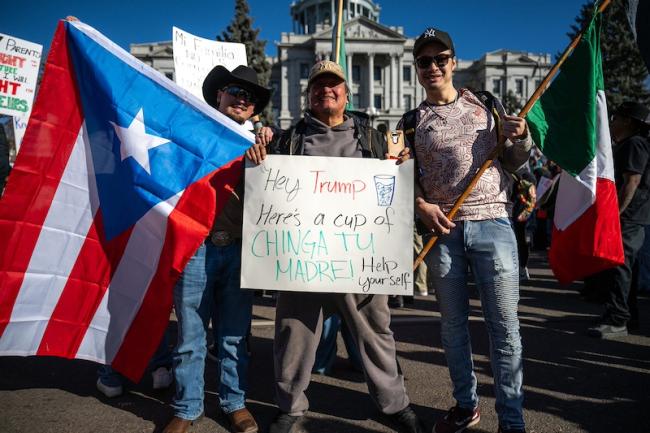
I’ll never forget a story my mother tells about being late for work one day at a kitchen in early 1980s Los Angeles. Had she been on time, she would have been caught in a raid and potentially sent back to war in El Salvador. Many of her coworkers were rounded up; some she never saw again, while others immigrated once more, crossing through Tijuana within days or weeks, undeterred and back on the clock. A worksite raid could easily be an anecdote from today. In recent weeks, thousands of immigrants have been detained and many deported in Immigration and Customs Enforcement (ICE) raids across the country.
Among the ongoing barrage of executive orders by President Donald Trump aiming to terrorize and overwhelm, the one eliminating “protected areas” sent shockwaves through immigrant communities all over major U.S. cities. Places that were once safe zones against ICE—hospitals, schools, and places of worship—are now no longer off-limits. This rollback of civil liberties is a direct attack on sanctuary cities and is an attempt to further undo the gains made by the sanctuary movement. However, this fight for safe spaces and immigrant rights did not begin in the Trump era, either this one or the last. The sanctuary movement has deep historical roots, extending back to the 1980s, when activists and communities organized to protect immigrants fleeing U.S.-sponsored civil wars in Central America.
There is no official definition of what constitutes a “sanctuary city” or jurisdiction, but the term loosely refers to locales where immigrants can find refuge and protection from federal immigration authorities. Over time, it has come to include official policies to protect undocumented residents in cities like Los Angeles, Boston, and Chicago. In 1985, not long after a raid targeted my mother’s place of work, the Los Angeles City Council adopted a resolution declaring the city a place of sanctuary for immigrants fleeing persecution and political violence in Guatemala and El Salvador. This was a precursor to the codification of sanctuary policies in cities and counties across the country in more recent years.
The Origins of the Sanctuary Movement
In her 1985 book I've Been a Woman: New and Selected Poems, the poet Sonia Sanchez includes a poem titled “MIA's (missing in action and other atlantas),” in which she connects the dots between the oppression of racism in Atlanta, apartheid-era Johannesburg, South Africa, and U.S. involvement in El Salvador. Of El Salvador, she wrote:
redwhiteandblue guns splinter the
nite with glass
redwhiteandblue death squads running on borrowed
knees cascading dreams
quiero ser libre
pues libre naci
I say
quiero ser libre
pues libre naci
Under the guise of fighting the spread of communism, the United States heavily funded right-wing death squads and militias in Central America in the 1980s, particularly in the civil wars in Guatemala, El Salvador, and Nicaragua. The sanctuary city movement of the 1980s was a direct response to this political and social turmoil. These conflicts created thousands of refugees, many of who sought asylum in the United States. However, they were met with resistance from the U.S. government, which largely denied refugee status and asylum protections to those fleeing violence.
Central American refugees, in particular, faced stringent immigration policies and were often characterized as economic migrants in an attempt to obscure their legitimate rights as refugees and evade protection from deportation. Providing refugee relief would be seen as an admission that the U.S. militarist policies in the region were harmful.
The Reagan administration’s propaganda went into overdrive to justify its military spending. In Reagan’s 1984 “Address to the Nation on United States Policy in Central America,” he stated that “San Salvador is closer to Houston, Texas, than Houston is to Washington, DC. Central America is America. It's at our doorstep, and it's become the stage for a bold attempt by the Soviet Union, Cuba, and Nicaragua to install communism by force throughout the hemisphere.”
In El Salvador, the war claimed at least 75,000 lives and displaced over 1 million people, many of whom, like my family, set their sights on the United States. The UN Truth Commission that investigated El Salvador’s war found that more than 80 percent of the atrocities were committed by U.S.-backed state agents. Deportations to El Salvador and its neighbors in the 1980s often amounted to death sentences, and a generation of activists, whose consciousness was shaped by the United States’s failure in the Vietnam war, were not having it.
The sanctuary movement arose in churches and community organizations as a direct act of resistance to these inhumane policies. In 1982, five churches in Berkeley, California, and one in Tucson, Arizona, held coordinated actions demanding that the U.S. government meet its moral and legal obligations to grant asylum to Central America refugees fleeing U.S.-sponsored death squads. These congregations declared their intent to “provide sanctuary—support, protection, and advocacy” to undocumented migrants seeking safety from deportation. Local government eventually followed suit, and sanctuary cities became a haven for many. These cities, including San Francisco, Los Angeles, and Chicago, offered immigrants a safe space, shielding them from deportation and allowing them to live and work without fear. These actions were not only a reaction to U.S. policies abroad but also to the actions of the U.S. government at home. Local activists organized grassroots campaigns to offer housing, legal aid, and financial support, all while directly disobeying federal laws that targeted immigrants.
Before ICE, there was INS
If ICE was a person, it would barely be old enough to drink. That means the 70-year history of the Immigration and Naturalization Service (INS) has mostly faded from public memory. I was taken aback recently when I met trained immigration advocates in their 20s who didn’t know the history of INS. For those of us who grew up in the 1980s and 1990s, INS was nightmare fuel—generating constant fear that they might snatch one of our immigrant parents while we were at school and they were at work.
INS was responsible for overseeing immigration enforcement actions from 1933 to 2003. It was the precursor to ICE, conducting raids, deportations, and detentions—especially during the 1980s—that targeted undocumented people. During this time, INS raids became notorious in immigrant communities. Immigrants were often targeted in workplace raids, and entire families were torn apart by deportations. The INS’s aggressive tactics contributed to the growing need for sanctuary spaces. As INS’s policies intensified, immigrant communities, especially those in cities with significant populations of Central American refugees, rallied to resist. These early sanctuary efforts were community-driven and sought to provide shelter, support, and legal aid to those at risk of deportation.
In 2003, President George W. Bush dissolved the INS and created the Department of Homeland Security (DHS), making ICE one of its primary agencies. In the post 9/11-era, this wasn’t just a rebrand of INS but an intensification of attacks against the civil liberties of those deemed as “Other.” ICE’s mission expanded beyond immigration enforcement to include customs, border control, and anti-terrorism efforts. Its creation marked a major shift in U.S. immigration enforcement, introducing more aggressive measures and larger budgets for enforcement and deportation.
In the 2010s, ICE’s role in immigration enforcement became even more controversial. Under the Barack Obama administration, record numbers of deportations earned Obama the nickname “Deporter-in-Chief” from immigration advocates. The deportation of people who had lived in the United States for years, many without criminal records, sparked a backlash from immigrant rights groups, communities, and local governments.
The battle over immigrant rights reached new levels under the first Trump administration, which threatened to cut federal funding to sanctuary cities. Sanctuary was once again at the forefront of the national debate, with more cities adopting policies to protect immigrants from ICE raids and detentions. While city and state governments are required to comply with federal immigration laws, these policies generally involve limiting local law enforcement cooperation with ICE and offering protections to undocumented individuals within certain city limits.
Now, these protections are under threat from Trump’s latest executive order targeting protected areas at the start of his second term.
The Past Comes Full Circle
In the 1980s, the sanctuary movement was part of a broader struggle for liberation, with leftist activists fighting to protect immigrants, advocate for refugee rights, and challenge U.S. foreign policy in Latin America. It was a time when the global HIV/AIDS pandemic was at its peak and anti-apartheid protests were happening alongside demonstrations against U.S. military involvement in Central America. Much like Sanchez’s poem linking state violence in Atlanta, South Africa, and El Salvador, the interconnectedness of international struggles takes on renewed urgency today. The United States and the world are similarly under assault by Trump’s policies, just as it was by Reagan back then. Today, popular movements against Israeli apartheid, including anti-war protests against genocide in Gaza, echo the turbulence of the 1980s. Today’s immigrant rights movement is deeply linked to these struggles as well.
The sanctuary movement, whether in the 1980s or today, is a testament to grassroots resistance against oppressive systems. It is important to remember that sanctuary cities didn’t emerge from government policy but from the direct actions of communities willing to defy unjust laws to protect vulnerable people. Today, over two dozen religious groups are suing in the federal government over Trump’s executive order that makes their houses of worship unsafe for immigrants in their congregations. The spirit of resistance—standing against federal forces for the sake of human dignity—remains alive. As we navigate this new repressive era, the history of the 1980s sanctuary movement and its impact on current immigration policy should not be forgotten. Just as everyday people fought for the rights of Central American refugees then, today's activists continue the fight as more anti-ICE protests crop up across the country against the Trump administration’s racist and xenophobic policies. Sanctuary was a movement then—it still is now. As Sonia Sanchez concluded her aforementioned poem:
cmon. men. women.
[we] want to be free.
Daniel Alvarenga is a journalist based in Washington, DC. He’s been writing about the intersection between politics, media and the Central American diaspora for over a decade. He’s previously worked at Al Jazeera and Telemundo. He’s a recipient of a Poynter Fellowship in Journalism by Yale University.

